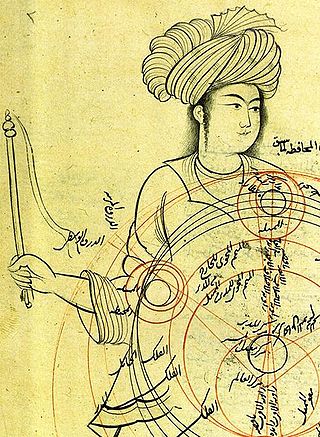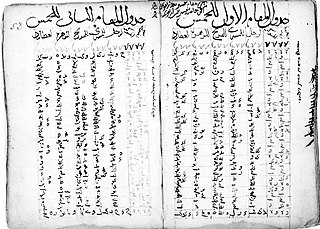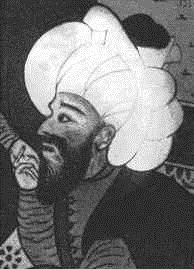
ʿAbu al-Ḥasan Alāʾ al‐Dīn bin Alī bin Ibrāhīm bin Muhammad bin al-Matam al-Ansari known as Ibn al-Shatir or Ibn ash-Shatir was an Arab astronomer, mathematician and engineer. He worked as muwaqqit in the Umayyad Mosque in Damascus and constructed a sundial for its minaret in 1371/72.
Athīr al‐Dīn al‐Mufaḍḍal ibn ʿUmar ibn al‐Mufaḍḍal al‐Samarqandī al‐Abharī, also known as Athīr al‐Dīn al‐Munajjim was an Iranian muslim polymath, philosopher, astronomer, astrologer and mathematician. Other than his influential writings, he had many famous disciples.

Al-Urdi was a medieval Syrian Arab astronomer and geometer.

Qotb al-Din Mahmoud b. Zia al-Din Mas'ud b. Mosleh Shirazi was a 13th-century Persian polymath and poet who made contributions to astronomy, mathematics, medicine, physics, music theory, philosophy and Sufism.

Medieval Islamic astronomy comprises the astronomical developments made in the Islamic world, particularly during the Islamic Golden Age, and mostly written in the Arabic language. These developments mostly took place in the Middle East, Central Asia, Al-Andalus, and North Africa, and later in the Far East and India. It closely parallels the genesis of other Islamic sciences in its assimilation of foreign material and the amalgamation of the disparate elements of that material to create a science with Islamic characteristics. These included Greek, Sassanid, and Indian works in particular, which were translated and built upon.

The Tusi couple is a mathematical device in which a small circle rotates inside a larger circle twice the diameter of the smaller circle. Rotations of the circles cause a point on the circumference of the smaller circle to oscillate back and forth in linear motion along a diameter of the larger circle. The Tusi couple is a 2-cusped hypocycloid.
Zīj-i Īlkhānī or Ilkhanic Tables is a Zij book with astronomical tables of planetary movements. It was compiled by the Muslim astronomer Nasir al-Din al-Tusi in collaboration with his research team of astronomers at the Maragha observatory. It was written in Persian and later translated into Arabic.
Islamic cosmology is the cosmology of Islamic societies. It is mainly derived from the Qur'an, Hadith, Sunnah, and current Islamic as well as other pre-Islamic sources. The Qur'an itself mentions seven heavens.

The Maragheh observatory, also spelled Maragha, Maragah, Marageh, and Maraga, was an astronomical observatory established in the mid 13th century under the patronage of the Ilkhanid Hulagu and the directorship of Nasir al-Din al-Tusi, a Persian scientist and astronomer. The observatory is located on the west side of Maragheh, which is situated in today's East Azerbaijan Province of Iran. It was considered one of the most advanced scientific institutions in Eurasia because it was a center for many groundbreaking calculations in mathematics and astronomy. It housed a large collection of astronomical instruments and books and it served as an educational institution. It was also used as a model for the later Ulugh Beg Observatory in Samarkand, the Taqi al-Din observatory in Constantinople, and Jai Singh observatory in Jaipur.
Muḥyī al‐Milla wa al‐Dīn Yaḥyā Abū ʿAbdallāh ibn Muḥammad ibn Abī al‐Shukr al‐Maghribī al‐Andalusī, referred to in sources as Muhyi l'din, was an astronomer, astrologer and mathematician of the Islamic Golden Age. He belonged to the group of astronomers associated with the Maragheh observatory in the Ilkhanate, most notably Nasir al-Din al-Tusi. In astronomy, Muhyi l'din carried out a large‐scale project of systematic planetary observations, which led to the development of several new astronomical parameters.

Copernican heliocentrism is the astronomical model developed by Nicolaus Copernicus and published in 1543. This model positioned the Sun at the center of the Universe, motionless, with Earth and the other planets orbiting around it in circular paths, modified by epicycles, and at uniform speeds. The Copernican model displaced the geocentric model of Ptolemy that had prevailed for centuries, which had placed Earth at the center of the Universe.

A zij is an Islamic astronomical book that tabulates parameters used for astronomical calculations of the positions of the sun, moon, stars, and planets.

Abdal Ali ibn Muhammad ibn Husayn Birjandi was a prominent 16th-century Persian astronomer, mathematician and physicist who lived in Birjand.

Ala al-Dīn Ali ibn Muhammed, known as Ali Qushji was a Timurid theologian, jurist, astronomer, mathematician and physicist, who settled in the Ottoman Empire some time before 1472. As a disciple of Ulugh Beg, he is best known for the development of astronomical physics independent from natural philosophy, and for providing empirical evidence for the Earth's rotation in his treatise, Concerning the Supposed Dependence of Astronomy upon Philosophy. In addition to his contributions to Ulugh Beg's famous work Zij-i-Sultani and to the founding of Sahn-ı Seman Medrese, one of the first centers for the study of various traditional Islamic sciences in the Ottoman Empire, Ali Kuşçu was also the author of several scientific works and textbooks on astronomy.
Edward Stewart Kennedy was a historian of science specializing in medieval Islamic astronomical tables written in Persian and Arabic.

Muhammad ibn Muhammad ibn al-Hasan al-Tusi, also known as Nasir al-Din al-Tusi or simply as (al-)Tusi, was a Persian polymath, architect, philosopher, physician, scientist, and theologian. Nasir al-Din al-Tusi was a well published author, writing on subjects of math, engineering, prose, and mysticism. Additionally, al-Tusi made several scientific advancements. In astronomy, al-Tusi created very accurate tables of planetary motion, an updated planetary model, and critiques of Ptolemaic astronomy. He also made strides in logic, mathematics but especially trigonometry, biology, and chemistry. Nasir al-Din al-Tusi left behind a great legacy as well. Tusi is widely regarded as one of the greatest scientists of medieval Islam, since he is often considered the creator of trigonometry as a mathematical discipline in its own right. The Muslim scholar Ibn Khaldun (1332–1406) considered Tusi to be the greatest of the later Persian scholars. There is also reason to believe that he may have influenced Copernican heliocentrism. Nasir proposed that humans are related to animals and that some animals have a limited level of awareness while humans have a superior level of awareness amongst animals.
Badr al‐Dīn ʿAbd al‐Wājidibn Muḥammad ibn Muḥammad al‐Ḥanafī was a 15th century Persian astronomer. He was born in Mashhad, in modern Iran, and died in Kütahya, in modern Turkey, He taught in the Ottoman Demirkapi Madrasa, a school for astronomical observation and instruction. The Demirkapi madrasa was later renamed as the Wājidiyya Madrasa in his honour.

Nizam al-Din Hasan al-Nisaburi, whose full name was Nizam al-Din Hasan ibn Mohammad ibn Hossein Qumi Nishapuri was a Persian Sunni Islamic Shafi'i, Ash'ari scholar, mathematician, astronomer, jurist, Qur'an exegete, and poet.
Tadhkirah (تذكرة), Arabic for "memorandum" or "admonition", is frequently used as part of the title of literary works of the nature of authoritative collections or summaries. It may refer to the following works:













